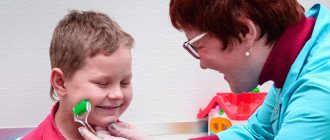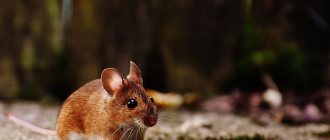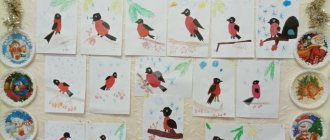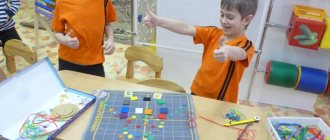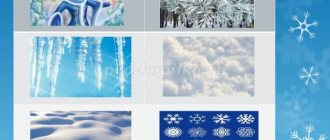Lexical topic “Winter”: ideas for activities during walks and at home
The change of seasons is an inevitable and natural phenomenon. Each season gives caring parents the opportunity to expand their child’s horizons, supplement their knowledge about the world around them with new facts, and replenish their repertoire of exciting activities with new games and exercises. Today we have prepared for you several ideas for updating the “Winter” theme.
On a walk
A lesson on the topic “Winter” is good to conduct with the onset of cold weather - in mid-to-late autumn, depending on the climate in your region.
While walking with your child, pay attention to the changes occurring in nature:
- discuss what trees look like;
- look for and explore frozen puddles;
- consider what clothes children and adults wear on the streets;
- tell us that the day has become shorter, and the night, on the contrary, is increasing.
The first snowfall opens up wide prospects for an educational walk.
When you wake up in the morning and find that the world outside your window has dressed up in its white robe, get ready to devote part of your day with your child to studying the properties of snow.
Start your day with a riddle:
It’s fluffy and silvery, but don’t touch it with your hand, it will become a droplet of clean, as soon as you catch it in the palm of your hand.
When the baby himself or with your help guesses that we are talking about snow, take him to the window. Try to create a joyful, festive atmosphere. Your sincere admiration for the beauty of nature, your keen interest in the metamorphoses occurring in nature are contagious for the little one. This is how, in everyday little things, in conversations with parents, a love for nature and all living things is formed, a thirst for knowledge, reasoning and analysis.
When dressing your child for a walk, discuss what clothes you choose. Go through the dictionary of the topic “Clothing”, remembering what outfits were relevant in spring, summer, and autumn.
During a walk, let your baby touch the snow with his palm.
- “What does the first snowball feel like?” - “Wet, cold, prickly.”
- "What colour is he?" - "White!"
- “What else can you say about snow?” - “It is clean, elegant, beautiful, sparkling, silver.”
Invite your little explorer to conduct an experiment with snow.
Take two small handfuls of snow. Place one on your palm and the other in your mitten.
- “Where did the snow melt most quickly?” - “In the palm of your hand.”
- "And why?" - “Because the palm is warm.”
The snow melted and turned into a small puddle. And this happened because snow is water that evaporated from the surface of the earth and reservoirs, rose into the sky in the form of steam, there it turned into a cloud and returned to the earth in the form of snow.
Please pay attention to the child that in winter birds and animals need our help. Discuss what you can do for them: make feeders, arrange warm houses for overnight stays, feed cats and dogs that are forced to spend the winter outside without owners.
Tell us how wild animals spend the winter.
Children at home
Magnificent ten: reading about winter
Classic and modern children's literature offers many options for winter reading with preschool children:
- Folk winter tales: “Two Frosts”, “Winter Hut of Animals”, “Frost and the Hare”;
- V. Suteev “Yolka”;
- E. Uspensky “Winter in Prostokvashino”;
- P. Bazhov “Silver Hoof”;
- D. Mamin-Sibiryak “Gray Neck”;
- S. Marshak “Twelve Months”;
- Paula Metcalf "Carlusha and the First Snow";
- Hazel Lincoln "How Little Bear Searched for the Sun";
- G.K. Andersen "The Snow Queen";
- Tove Jansson "Magic Winter".
Home workshop: crafts made from natural materials “Leshy’s House”
Joint creativity with children is an excellent opportunity to work on developing imagination, practice fine motor skills, and once again remember the characteristic features of winter.
For the craft, prepare:
- dry tree branches;
- sticks (thicker branches) in sufficient quantity;
- coniferous branches;
- lump;
- acorn cap;
- dry leaves;
- honey locust seeds;
- cotton wool;
- a small piece of foam;
- plasticine (preferably dark color);
- scotch;
- universal glue;
- cardboard for the roof;
- a board or thick cardboard for the base.
Let's get started:
- Mark on the base where the house will be located (it should take up about a quarter of your sheet or board), where the goblin is, where the trees are.
- Make a frame. To do this, use plasticine to fasten the prepared thick sticks in the form of squares superimposed on each other (like a well). Attach the finished frame to the base using glue and plasticine.
- What is a house without doors and windows? These parts of the structure can be made from paper strips, but the reverse side of the bark, which can be cut from unused sticks, will look more interesting.
- Now it's the roof's turn. We will make it from cardboard, cutting out 4 triangles with a base along the width of the walls. Fold the triangles into a pyramid, gluing them along the inside with tape. Now let’s place our pyramid-roof on the walls, having previously coated the top stick with glue. The house is ready!
- A goblin will live in the house, which we will make from a pine cone. Let's put an acorn hat on the forest dweller's head. We will make arms and legs from thin twigs. We will paint the eyes with paint or glue pieces of cardboard. We'll put the goblin next to the house.
- To prevent the landscape from being dull, we will decorate the local area with trees made from twigs and dry leaves. To make our trees snow-covered, coat the branches with glue and sprinkle with foam crumbs.
- Apply glue to the base of the craft and the roof of the house. Place fluffy cotton wool on the glue. It turned out very elegant, very snowy!
- All that remains is to use glue and the remaining sticks to make a fence along the base. Don't forget to leave a passage. Use honey locust seeds (can be replaced with sunflower seeds) to lay out a path to the house.
You have created a beautiful house in a winter landscape with your own hands. You can participate in a crafts competition in kindergarten or decorate the interior of a children's room.
Winter drawings
Almost all kids love to draw. The theme for a winter drawing could be:
- snowman;
- elegant Christmas tree;
- snowy forest;
- children on a winter walk;
- animals in winter.
And to make the lesson even more interesting (so much so that even those who usually don’t show much zeal for drawing will like it), offer to work in original techniques:
- Drawing with cereals . Use PVA glue to apply a design to the paper. Sprinkle it with cereal, carefully shake off the remains. For winter work, it is better to use semolina: the picture will look like it was painted with snow.
- Drawing with toothpaste . White toothpaste on colored cardboard or paper is very similar to real snow. Add a little colored gouache and you have an excellent material for colorful drawings. It is convenient to apply this paint to the base using cotton swabs.
- Drawing with a stencil . Prepare stencils from thick cardboard: a snowman, a family of polar bears, a Christmas tree, etc. Securely fasten the stencils to the sheet. Let the child create a background using any technique that is pleasant to him (drawing with splashes, foam rubber, sweeping strokes, etc.). Now let’s remove the stencils and enjoy the result.
Friends, don’t forget to tell your child about winter, expand his “winter” vocabulary of objects, signs and actions, learn New Year’s poems and prepare to meet Santa Claus. We'd love to read about your options for winter fun at home and outside. Leave your comments on the article or write on our pages in social groups.
May your parenting be happy. See you again!
